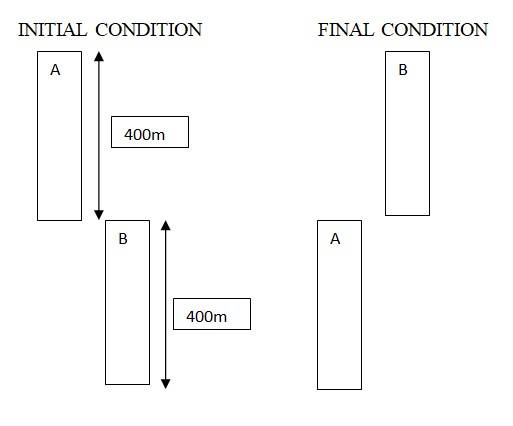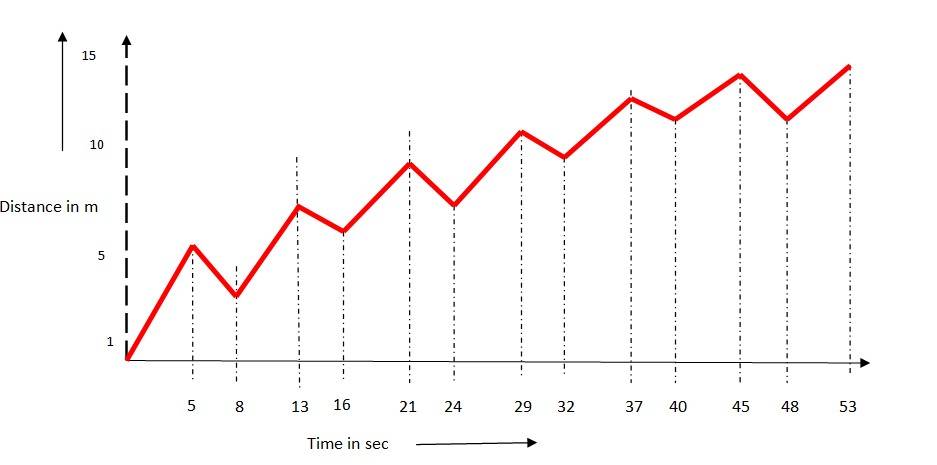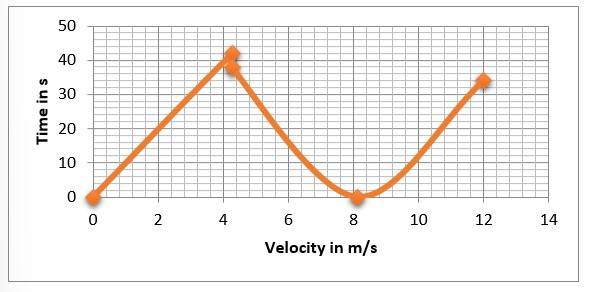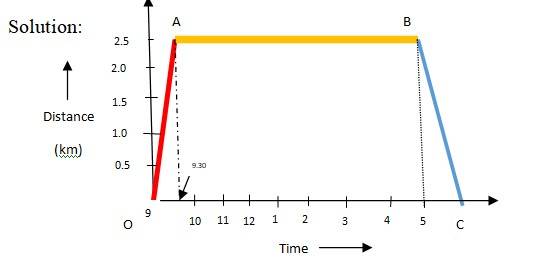Motion in a Straight Line
Get insights from 82 questions on Motion in a Straight Line, answered by students, alumni, and experts. You may also ask and answer any question you like about Motion in a Straight Line
Follow Ask QuestionQuestions
Discussions
Active Users
Followers
New answer posted
7 months agoContributor-Level 10
Given data:
Initial height, h = 90 m
Acceleration due to gravity, g = 9.8 ms2
Speed lost at each collision = 1/10 of its speed
time interval to be considered: 0 to 12 secs.
Step 1: Time to fall from 90 m
h = ½ gt2 ⇒ 90 = 21 * 9.8 * t2 ⇒ t2 = 9.8180 ≈ 18.37 ⇒ t ≈ 4.29 seconds
Step 2: Speed before first impact
v = gt = 9.8 * 4.29 ≈ 42 m/s
After hitting the floor with 42 m/s, ball rebound with;
vrebound = 0.9*42 = 37.8m/s
Step 3:
Max height after rebound:
Use:
t = g / v = 37.8 / 9.8 ≈ 3.86s
Again, the b
New answer posted
7 months agoContributor-Level 10
3.11
(a) True – zero speed may have a non zero instantaneous non-zero acceleration
(b) False – zero speed will always make zero velocity
(c) True – constant speed will have zero acceleration
(d) False – If the positive value of acceleration is in the direction of its motion then it can speed up
New answer posted
7 months agoContributor-Level 10
3.10
(a) The direction of the acceleration is downward during the upward motion of the ball because the acceleration is due to gravity. Gravity always pulls the object toward the centre of the earth.
(b) Velocity: At the peak the velocity is zero because the ball momentarily stops before falling downwards.
Acceleration: g = 9.8 ms–2
(c) If we consider the highest point x = 0 m, t= 0 s,
During upward motion of the ball before it reaches the maximum height, x = +ve, velocity = -ve, acceleration = +ve. During downward motion, x = +ve, velocity = +ve, acceleration = +ve
(d) At the highest point, final velocity v = 0, initial vel
New answer posted
7 months agoContributor-Level 10
3.9 Cycling speed = 20 kmph
Let as assume speed of the bus is
The relative velocity of the buses in the direction of motion of the cyclist = -
Buses go past him every 18 mins = 18/60h = 0.3h
Distance covered = ( ) * 0.3
Since the buses leave every T minutes, ( ) * 0.3 = * (T/60) ……(1)
The relative velocity of the buses in the opposite direction of the cyclist = +
Buses go past him in the opposite direction = every 6 m = 6/60 h
Distance covered = ( + ) * 1/10
Since the buses leave every T minute, we get ( + ) * 1/10
New answer posted
7 months agoContributor-Level 10
3.8

Speed of car A, Va = 36 kmph = 10m/s
Speed of car B, Vb = 54 kmph = 15 m/s
Speed of car C, Vc = -54 kmph = -15 m/s
Relative speed of A, w.r.t. C = Va – (-Vb) = 10 +15 = 25 m/s
Relative speed of B, w.r.t. A = Vb-Va = 15-10 = 5 m/s
Distance between AB & AC = 1 km = 1000m
Time taken by the car C to cover the distance AC, from s = ut
We get t = 1000/25 = 40s
To avoid collision with C, the minimum acceleration the vehicle B must have, from the relation, s = ut + (1/2) ft2
We get 1000 = 5 * 40 + (1/2) f * 402 f = 1 m/s2
New answer posted
7 months agoContributor-Level 10
3.7 The uniform speed of A and B = 72 kmph = 20 m/s

The acceleration f = 1 m/s2, time t = 50 s
Distance covered by train B = ut + 0.5 * ft2 = 20 * 50 + 0.5 * 1 * 50 2 = 2250 m
Distance covered by train A in the same period = ut = 50 * 20 = 1000 m
So the initial distance train A and train B was = 2250 – 1000 = 450 m
New answer posted
7 months agoContributor-Level 10
3.6 The speed of the car = 126 kmph = (126 * 1000/3600) m/sec = 35 m/s
From the relation V2 = U2 + 2fs, where Final velocity V = 0, U = 35 m/s, s = 200m, we get retardation, f = -U2/2s= 3.06 m2/s
From the relation V = U – ft, we get t = U/f = 35/3.06 = 11.42 s.
New answer posted
7 months agoContributor-Level 10
3.5 The speed of the jet plane, Vj = 500 kmph. If the speed of the product of combustion is Vpc, then V pc = Vpc-Vj = -1500 kmph (relative to the jet plane)
Speed of the combustion product relative to the observer on the ground,
Vpc = -1500 + Vj = -1500+500 = -1000 kmph
New answer posted
7 months agoContributor-Level 10
3.4

The time taken for each step is 1s, he covers 5 m in 5 secs and goes backward by 3 m in 3 secs.
So in 8 s he covers 2 m. To cover 13m distance he needs to complete 8 m (13-5). To cover 8m, he will require 8 * 4 = 32 s. To fall in a pit, he needs to move another 5m in 5s.
So total time taken = 32 +5 = 37 s
Let's have a look at how we came to this answer.
We have to calculate how long it will take for the drunkard to fall into a pit located 13 metres from his starting point.
In each cycle of movement, the drunkard takes 5 steps forward and 3 steps backward. We calculate the net displacement per cycle.
Time for one cycle = 5 seco
New answer posted
7 months agoContributor-Level 10
3.3 Office distance = 2.5 km
Walking speed = 5 kph
Time taken to reach office = 5/2.5 = 0.5 h
OA is the path to reach office
AB is the duration of office stay
Auto speed = 25 kph
Time taken by auto = 2.5/25 h = 6 minutes
BC is the path for returning
On the position-time graph, this is a straight line sloping downwards. It starts at the point representing 5:00 PM and 2.5 km, and ends at 5:06 PM at 0 km. It tells us that the woman has arrived home.
The slope of this line represents instantaneous velocity. Because the return trip is by the auto at a much higher speed (25 km/h), the slope of line BC is significantly steeper than the line
Taking an Exam? Selecting a College?
Get authentic answers from experts, students and alumni that you won't find anywhere else
Sign Up on ShikshaOn Shiksha, get access to
- 66k Colleges
- 1.2k Exams
- 680k Reviews
- 1800k Answers


